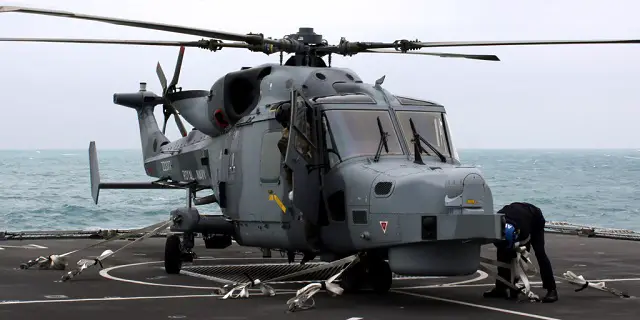Breaking news
Royal Navy AW-159 Wildcat maritime helicopter takes part in Exercise Joint Warrior.
| |
|||
| a | |||
Naval
Forces News - UK |
|||
Royal
Navy AW-159 Wildcat maritime helicopter takes part in Exercise Joint
Warrior |
|||
The newest helicopter in the Royal Navy’s arsenal came through
its toughest test yet as it spent a fortnight taking part in Europe’s
biggest naval war games. Wildcat – which will provide the aerial
eyes and punch of the Royal Navy’s frigates and destroyers for
the next quarter of a century – joined HMS Dragon on Exercise
Joint Warrior. It is the first time the helicopter – normally based at RNAS Yeovilton in Somerset with 700W Naval Air Squadron – has spent such a concerted time at sea, and the first time it has taken part in the exercise aboard a ship. |
|||
 The
Wildcat helicopter being strapped to HMS Dragon's flight deck The
Wildcat helicopter being strapped to HMS Dragon's flight deckRoyal Navy picture |
|||
From
next year, Wildcat will start to replace the Lynx as the mainstay of
aerial operations by the Royal Navy’s Type 23 frigates and Type
45 destroyers, superseding a helicopter which in various variants has
served the Fleet Air Arm with distinction for 40 years.
Although it looks similar to its predecessor, Wildcat is a different aircraft, from the way it handles, to the equipment aboard – which is a generation ahead of that on the Lynx. Wildcat has undergone more than four years of trials which have tested the airframe to the limit and set the rules for what the helicopter can do on and off the flight deck, the emphasis has shifted to how to use Wildcat on the front line – what the military call tactical development. Wildcat pilot, Lieutenant Dave Neyland, said: “On this deployment our focus was working on tactical development – the chance to be at sea with so many other ships and submarines, from across the world, was not one to be missed.” The nature of Joint Warrior, which features pretty
much every face of naval warfare: submarine, surface, fast-attack
craft, amphibious assault – which means it’s about as
thorough a workout a new helicopter bristling with cutting-edge equipment
can hope to find in one place. “The range and clarity of the sensors, including the radar and onboard cameras, meant that building the maritime picture was more accurate and faster than in the older Lynx,” said Lt Sammy Haynes, the Wildcat’s observer who was monitoring the reams of data the helicopter’s suite of sensors was picking up. Later this year Wildcat will go through two months of intensive Operational Sea Training with a Type 23 frigate to prepare ship and helicopter for deployment. Wildcat is due to be declared operational in early 2015 and is due to deploy for the first time with a Royal Navy warship on the North Atlantic patrol next May – by which time Dragon’s second deployment should just about be complete. After a successful maiden deployment – eight months in the Gulf and eastern Mediterranean – the destroyer is devoting the first half of 2014 to preparing for her second tour of duty. Following a high-profile visit to her twin town of Cardiff to receive the Freedom of the City and Operational Sea Training, the Type 45 destroyer will deploy again in October – fewer than 12 months year after returning from her last operational tour. “This year has already been another of many firsts for Dragon and we were delighted to assist in this way to bring on the capability of this aircraft,” said Capt Iain Lower, the destroyer’s Commanding Officer. “It was fantastic for all of my sailors to work
with the Wildcat team and to have the aircraft aboard a Type 45 for
such a long period. A brand new aircraft on the Navy’s newest
warship is more evidence of the exciting future ahead of us.” |


























